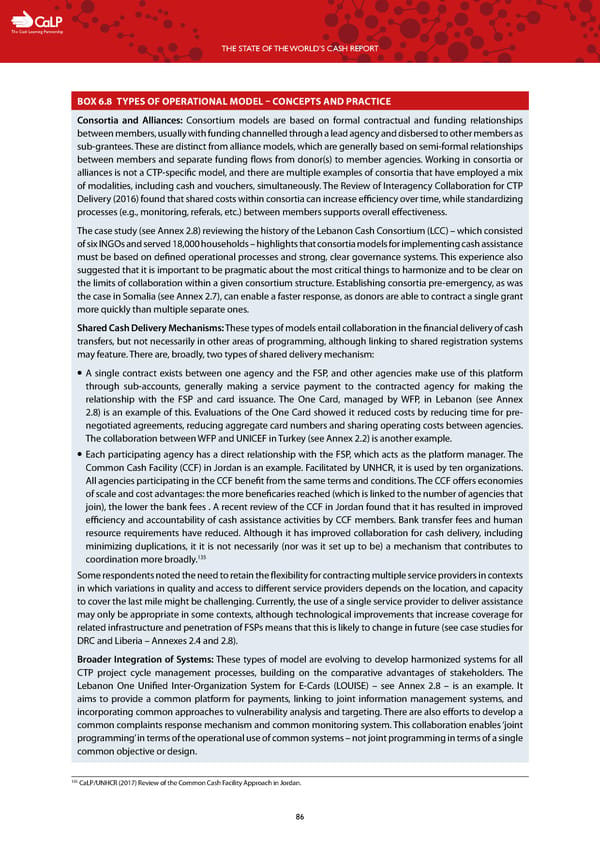C The Cash Learning Partnership THE STATE OF THE WORLD’S CASH REPORT BOX 6.8 TYPES OF OPERATIONAL MODEL – CONCEPTS AND PRACTICE Consortia and Alliances: Consortium models are based on formal contractual and funding relationships between members, usually with funding channelled through a lead agency and disbersed to other members as sub-grantees. These are distinct from alliance models, which are generally based on semi-formal relationships between members and separate funding flows from donor(s) to member agencies. Working in consortia or alliances is not a CTP-specific model, and there are multiple examples of consortia that have employed a mix of modalities, including cash and vouchers, simultaneously. The Review of Interagency Collaboration for CTP Delivery (2016) found that shared costs within consortia can increase efficiency over time, while standardizing processes (e.g., monitoring, referals, etc.) between members supports overall effectiveness. The case study (see Annex 2.8) reviewing the history of the Lebanon Cash Consortium (LCC) – which consisted of six INGOs and served 18,000 households – highlights that consortia models for implementing cash assistance must be based on defined operational processes and strong, clear governance systems. This experience also suggested that it is important to be pragmatic about the most critical things to harmonize and to be clear on the limits of collaboration within a given consortium structure. Establishing consortia pre-emergency, as was the case in Somalia (see Annex 2.7), can enable a faster response, as donors are able to contract a single grant more quickly than multiple separate ones. Shared Cash Delivery Mechanisms: These types of models entail collaboration in the financial delivery of cash transfers, but not necessarily in other areas of programming, although linking to shared registration systems may feature. There are, broadly, two types of shared delivery mechanism: — A single contract exists between one agency and the FSP, and other agencies make use of this platform through sub-accounts, generally making a service payment to the contracted agency for making the relationship with the FSP and card issuance. The One Card, managed by WFP, in Lebanon (see Annex 2.8) is an example of this. Evaluations of the One Card showed it reduced costs by reducing time for pre- negotiated agreements, reducing aggregate card numbers and sharing operating costs between agencies. The collaboration between WFP and UNICEF in Turkey (see Annex 2.2) is another example. — Each participating agency has a direct relationship with the FSP, which acts as the platform manager. The Common Cash Facility (CCF) in Jordan is an example. Facilitated by UNHCR, it is used by ten organizations. All agencies participating in the CCF benefit from the same terms and conditions. The CCF offers economies of scale and cost advantages: the more beneficaries reached (which is linked to the number of agencies that join), the lower the bank fees . A recent review of the CCF in Jordan found that it has resulted in improved efficiency and accountability of cash assistance activities by CCF members. Bank transfer fees and human resource requirements have reduced. Although it has improved collaboration for cash delivery, including minimizing duplications, it it is not necessarily (nor was it set up to be) a mechanism that contributes to 135 coordination more broadly. Some respondents noted the need to retain the flexibility for contracting multiple service providers in contexts in which variations in quality and access to different service providers depends on the location, and capacity to cover the last mile might be challenging. Currently, the use of a single service provider to deliver assistance may only be appropriate in some contexts, although technological improvements that increase coverage for related infrastructure and penetration of FSPs means that this is likely to change in future (see case studies for DRC and Liberia – Annexes 2.4 and 2.8). Broader Integration of Systems: These types of model are evolving to develop harmonized systems for all CTP project cycle management processes, building on the comparative advantages of stakeholders. The Lebanon One Unified Inter-Organization System for E-Cards (LOUISE) – see Annex 2.8 – is an example. It aims to provide a common platform for payments, linking to joint information management systems, and incorporating common approaches to vulnerability analysis and targeting. There are also efforts to develop a common complaints response mechanism and common monitoring system. This collaboration enables ‘joint programming’ in terms of the operational use of common systems – not joint programming in terms of a single common objective or design. 135 CaLP/UNHCR (2017) Review of the Common Cash Facility Approach in Jordan. 86
 The State of the World's Cash | Full Report Page 87 Page 89
The State of the World's Cash | Full Report Page 87 Page 89